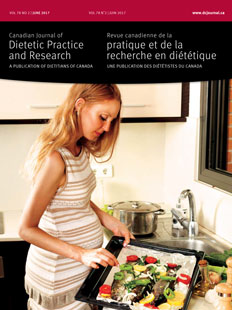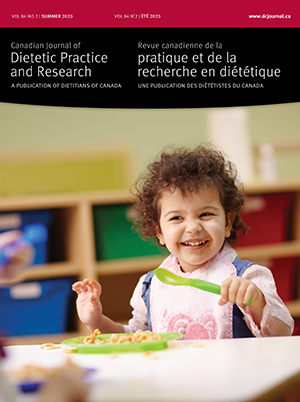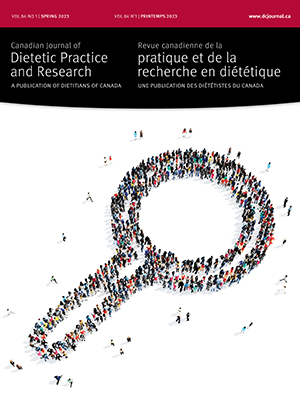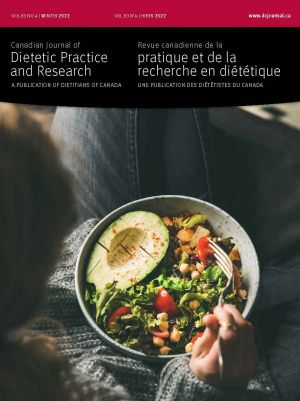Volume 78 • Number 2 • June 2017
Chair's Message
Editor's Message
Research
Purpose: To better understand how consumers use the Nutrition Facts Table (NFT) in their everyday shopping decisions and food consumption habits.Methods: Thirteen Canadian females were interviewed about how they use the NFT in their food choices.Results: Different elements of the front of the package served different purposes. Health claims and health checks drew attention to the product, but were not highly trusted. Ingredient lists were used to find “real food.” NFTs were considered important with each participant reporting an individualized strategy for using the NFT characterized by the application of benchmarks and blinders. The term “blinders” reflected only seeing and using one specific nutrient by assessing whether or not it exceeded a certain “benchmark” established by the participant. Therefore, the level of one specific nutrient determined the healthfulness of the product and the subsequent purchase/consumption decision.Conclusions: Findings suggest that NFTs should be redesigned. Some ideas for redesign include only listing “unhealthy” nutrients, having serving sizes more congruent to what is eaten in a typical sitting, making it easier to identify when a food may be high in a nutrient, and providing ways to allow the NFT to be used to meet personal, individualized needs.
Purpose: To compare docosahexaenoic acid (DHA), eicosapentaenoic acid (EPA), and fish intake of pregnant women at 30 weeks of gestation to current recommendations and to determine the factors associated with omega-3 (ω-3) intake.Methods: A food frequency questionnaire was completed by 54 women (54/131 = 41%) at 30 ± 0.8 weeks gestation. Supplement intake, sociodemographic characteristics, and ω-3 food habits were evaluated.Results: Among this high socioeconomic status (SES) group, 66.7% and 64.8% met the Food and Agriculture Organization of the United Nations (FAO)/World Health Organization (WHO) recommendation of 200 mg/d DHA and 300 mg/d DHA + EPA, respectively, and only 48.1% met the Academy of Nutrition and Dietetics (Academy) recommendation of 500 mg/d DHA + EPA. Eighteen of the 54 women took a ω-3 supplement during the third trimester. This significantly improved their total intake to meet the FAO/WHO (88.9% ≥200 mg/d DHA and 94.4% ≥300 mg/d DHA + EPA) and the Academy (77.8% ≥500 mg/d DHA + EPA) recommendations. Among nonsupplement users (36/54), 50% met the FAO/WHO recommendations and only 33.3% met the Academy recommendations.Conclusions: Results suggest that the majority of high SES women did not meet ω-3 recommendations from food alone. Continued prenatal education on the importance of fish intake and on the addition of ω-3 prenatal supplement is essential.
Purpose: We aimed to describe adherence to gestational weight gain (GWG) recommendations and identify determinants of excessive GWG in a sample of women from Quebec, Canada.Methods: Data were collected from the multi-centre 3D (Design, Develop, Discover) pregnancy cohort study, which included women who delivered between May 2010 and August 2012 at 9 obstetrical hospitals in Quebec, Canada. GWG was calculated for 1145 women and compared to the 2009 Institute of Medicine (IOM) recommendations.Results: Overall, 51% of participants exceeded the recommendations. Approximately 68% of women with obesity gained weight in excess of the IOM recommendations. The corresponding numbers were 75%, 44%, and 27% in overweight, normal weight, and underweight women, respectively. A prepregnancy BMI of 25 kg/m2 or more was the only significant predictor of exceeding GWG recommendations (OR 3.35, 95% CI 2.44–4.64) in a multivariate model. Birth weight was positively associated with GWG. GWG and prepregnancy BMI could explain 3.13% and 2.46% of the variance in birth weight, respectively.Conclusion: About half of women exceeded GWG recommendations, and this was correlated with infant birth weight. This reinforces the need to develop and evaluate strategies, including nutritional interventions, for pregnant women to achieve optimal GWG.
Purpose: This study investigated relationships between psychosocial and treatment-related factors, diet, and weight change in women treated with chemotherapy for early-stage breast cancer.Methods: Comprehensive qualitative interviews were conducted with 28 women who were within 12 months of completing chemotherapy treatment.Results: Changes in food intake and eating patterns were universal over the course of chemotherapy, with broad variability in treatment effects and associated dietary responses linked to weight change. Increased appetite, food cravings, and intake of energy-dense comfort foods were more common among women who gained weight during treatment (n = 11). Changes in taste, nausea, and emotional distress were central in promoting these dietary responses. Women who lost weight during treatment (n = 6) tended to report more severe and persistent side effects of treatment leading to poor appetite and lower food intake, and they were more likely to live alone.Conclusions: While the etiology of weight change in this population is complex, this study suggests that changes in food intake related to treatment and psychosocial challenges may play an important role for some women. These findings may help to identify women who are most at risk of weight change during treatment and may inform the development of tailored dietary interventions.
Perspecitves in Practice
Based on a 1999 needs assessment a pediatric community-based outpatient dietitian counselling service was created. By 2010 annual referrals had grown to almost 1500 (62% from physicians; 38% from public health nurses). An evaluation was undertaken to gather perspectives of practitioners and parents about access, satisfaction, referral practices, and changes in knowledge, attitudes, behaviour, and child well-being. Health professionals surveyed via email were 62 pediatricians (response rate 71%), 25 family physicians (21%), 87 public health nurses (31%), and 7 dietitian providers (100%). Parents (n = 93, response rate 75% of those contacted) were interviewed by telephone. Pediatricians reported a significantly lower rate of 7% (95% confidence interval (CI), 0.8%–23%) for admitting children to hospital to access a dietitian, compared to 1999 of 39% (95% CI, 22%–59%) (P = 0.005). Health professionals reported a high degree of agreement on benefits of the service to their practice and on child health problems and a high degree of satisfaction with the service. Parents reported gaining knowledge (76%), confidence (93%), and making behaviour changes in foods offered (77%). Our evaluation demonstrated health practitioners saw a need for access to dietitians for pediatric dietitian counselling and parents reported more confidence and improved child feeding practices after dietitian counselling.
This purpose of this study was to compare the nutritional content of vegetarian recipes published in food blogs written by registered dietitians (RDs) and by non-registered dietitians (non-RDs). Twelve food blogs written by RDs and 12 written by non-RDs were selected using a systematic approach. For each food blog, 2 vegetarian entrée recipes per season were selected (n = 192 recipes). Descriptive analyses were performed using Fisher’s exact test. Median nutritional values per serving between RDs’ and non-RDs’ recipes were compared using Wilcoxon–Mann–Whitney tests. RDs’ recipes were significantly lower in energy, non-heme iron, vitamin C, and sodium, contained significantly more vitamin D and had a higher protein proportion than non-RDs’ recipes. Disparities were also observed across type of entrée and vegetarian dietary pattern. In conclusion, this study showed that RD and non-RD food bloggers provided vegetarian recipes with few nutritional differences. Whether expanding the comparative analysis between RDs and non-RDs’ blogs targeting different nutrition-related topics would yield different results remains to be investigated.
Review
School breakfast programs are widespread and serve varying objectives regarding youth health promotion. Evidence-based guidelines for breakfast programs may be important in maximizing their effectiveness related to student outcomes, yet it is unclear what is available in Canada. A systematic review was conducted to identify and compare Canadian guidelines related to breakfast programs. Data sources included grey literature databases, customized search engines, targeted websites, and content expert consultations. Eligible guidelines met the following criteria: government and nongovernment sources at the federal and provincial/territorial levels, current version, and intended for program coordinators. Recommendations for program delivery were extracted, categorized, and mapped onto the 4 environments outlined in the ANGELO framework, and they were classified as “common” or “inconsistent” across guidelines. Fifteen sets of guidelines were included. No guidelines were available from federal or territorial governments and 4 provincial governments. There were few references to peer-reviewed literature within the guidelines and despite many common recommendations for program delivery, conflicting recommendations were also identified. Potential barriers to program participation, including a lack of consideration of allergies and other dietary restrictions, were identified. Future research should identify how guidelines are implemented and evaluate what effect their implementation has on program delivery and student outcomes.










